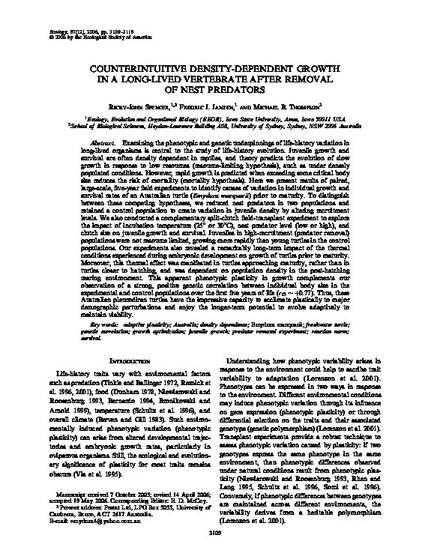
Examining the phenotypic and genetic underpinnings of life-history variation in long-lived organisms is central to the study of life-history evolution. Juvenile growth and survival are often density dependent in reptiles, and theory predicts the evolution of slow growth in response to low resources (resource-limiting hypothesis), such as under densely populated conditions. However, rapid growth is predicted when exceeding some critical body size reduces the risk of mortality (mortality hypothesis). Here we present results of paired, large-scale, five-year field experiments to identify causes of variation in individual growth and survival rates of an Australian turtle (Emydura macquarii) prior to maturity. To distinguish between these competing hypotheses, we reduced nest predators in two populations and retained a control population to create variation in juvenile density by altering recruitment levels. We also conducted a complementary split-clutch field-transplant experiment to explore the impact of incubation temperature (25° or 30°C), nest predator level (low or high), and clutch size on juvenile growth and survival. Juveniles in high-recruitment (predator removal) populations were not resource limited, growing more rapidly than young turtles in the control populations. Our experiments also revealed a remarkably long-term impact of the thermal conditions experienced during embryonic development on growth of turtles prior to maturity. Moreover, this thermal effect was manifested in turtles approaching maturity, rather than in turtles closer to hatching, and was dependent on population density in the post-hatching rearing environment. This apparent phenotypic plasticity in growth complements our observation of a strong, positive genetic correlation between individual body size in the experimental and control populations over the first five years of life (rG +0.77). Thus, these Australian pleurodiran turtles have the impressive capacity to acclimate plastically to major demographic perturbations and enjoy the longer-term potential to evolve adaptively to maintain viability.
Available at: http://works.bepress.com/fredric-janzen/24/

This article is from Ecology 87 (2006): 3109, doi: 10.1890/0012-9658(2006)87[3109:CDGIAL]2.0.CO;2. Posted with permission.